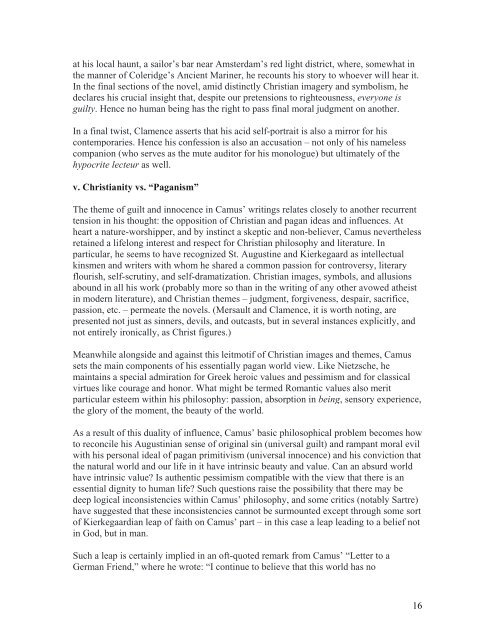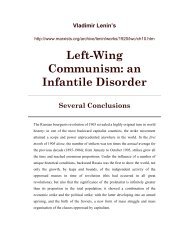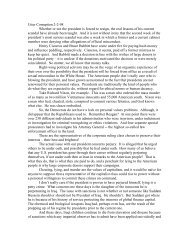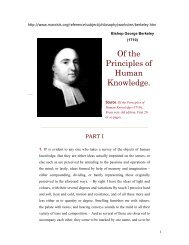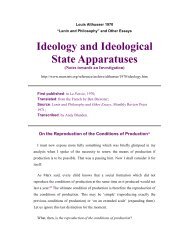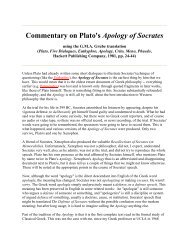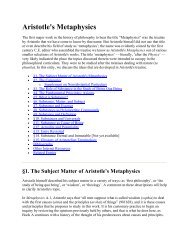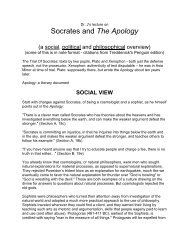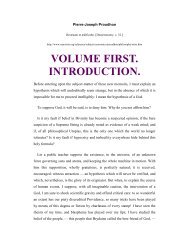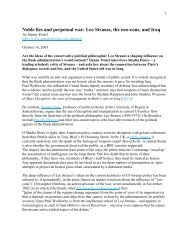Albert Camus (1913â1960) - Richard Curtis
Albert Camus (1913â1960) - Richard Curtis
Albert Camus (1913â1960) - Richard Curtis
You also want an ePaper? Increase the reach of your titles
YUMPU automatically turns print PDFs into web optimized ePapers that Google loves.
at his local haunt, a sailor’s bar near Amsterdam’s red light district, where, somewhat in<br />
the manner of Coleridge’s Ancient Mariner, he recounts his story to whoever will hear it.<br />
In the final sections of the novel, amid distinctly Christian imagery and symbolism, he<br />
declares his crucial insight that, despite our pretensions to righteousness, everyone is<br />
guilty. Hence no human being has the right to pass final moral judgment on another.<br />
In a final twist, Clamence asserts that his acid self-portrait is also a mirror for his<br />
contemporaries. Hence his confession is also an accusation – not only of his nameless<br />
companion (who serves as the mute auditor for his monologue) but ultimately of the<br />
hypocrite lecteur as well.<br />
v. Christianity vs. “Paganism”<br />
The theme of guilt and innocence in <strong>Camus</strong>’ writings relates closely to another recurrent<br />
tension in his thought: the opposition of Christian and pagan ideas and influences. At<br />
heart a nature-worshipper, and by instinct a skeptic and non-believer, <strong>Camus</strong> nevertheless<br />
retained a lifelong interest and respect for Christian philosophy and literature. In<br />
particular, he seems to have recognized St. Augustine and Kierkegaard as intellectual<br />
kinsmen and writers with whom he shared a common passion for controversy, literary<br />
flourish, self-scrutiny, and self-dramatization. Christian images, symbols, and allusions<br />
abound in all his work (probably more so than in the writing of any other avowed atheist<br />
in modern literature), and Christian themes – judgment, forgiveness, despair, sacrifice,<br />
passion, etc. – permeate the novels. (Mersault and Clamence, it is worth noting, are<br />
presented not just as sinners, devils, and outcasts, but in several instances explicitly, and<br />
not entirely ironically, as Christ figures.)<br />
Meanwhile alongside and against this leitmotif of Christian images and themes, <strong>Camus</strong><br />
sets the main components of his essentially pagan world view. Like Nietzsche, he<br />
maintains a special admiration for Greek heroic values and pessimism and for classical<br />
virtues like courage and honor. What might be termed Romantic values also merit<br />
particular esteem within his philosophy: passion, absorption in being, sensory experience,<br />
the glory of the moment, the beauty of the world.<br />
As a result of this duality of influence, <strong>Camus</strong>’ basic philosophical problem becomes how<br />
to reconcile his Augustinian sense of original sin (universal guilt) and rampant moral evil<br />
with his personal ideal of pagan primitivism (universal innocence) and his conviction that<br />
the natural world and our life in it have intrinsic beauty and value. Can an absurd world<br />
have intrinsic value? Is authentic pessimism compatible with the view that there is an<br />
essential dignity to human life? Such questions raise the possibility that there may be<br />
deep logical inconsistencies within <strong>Camus</strong>’ philosophy, and some critics (notably Sartre)<br />
have suggested that these inconsistencies cannot be surmounted except through some sort<br />
of Kierkegaardian leap of faith on <strong>Camus</strong>’ part – in this case a leap leading to a belief not<br />
in God, but in man.<br />
Such a leap is certainly implied in an oft-quoted remark from <strong>Camus</strong>’ “Letter to a<br />
German Friend,” where he wrote: “I continue to believe that this world has no<br />
16


